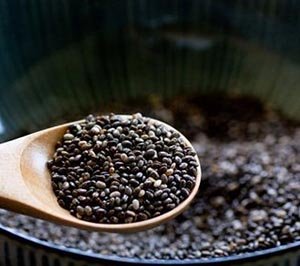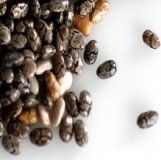Chia seeds Nutrition facts
Does chia seeds are packed with all the nutrients to label them as numero uno, ultimate foodgrains? Alternatively, are they just another novel entrant to the spectrum of food items so-called "superfoods"?
Chia are tiny, oblong-shaped, oilseeds consumed as one of the staples by the ancient Aztecs. The crop, in fact, was cultivated in the same measure as corn and amaranth by native Mexicans.
Nutrition experts believe that chia tops the list of functional foods because of its wholesome nutritional properties. In fact, nutrition planners are now looking up at chia as a single, wholesome source of phytonutrients such as omega-3 fatty acids (α -Linolenic acid), antioxidants, minerals, vitamins, and dietary fiber composed in the right proportions.
Botanically, chia is a low-growing herb in the mint family of plants. Scientific name: Salvia hispanica.
 |
| Chia seeds |
Chia (Salvia hispanica) is a small, annual, drought-tolerant, flowering herb. It flourishes well under sandy, fertile soils.
 |
| Chia seeds-close up view. |
Chia seeds come in variegated colors depending upon cultivar type and may vary from black, and brown to off-white. Its seeds measure about 1 mm in diameter and resemble miniature pinto beans. Its smooth outer cover is made up of a hygroscopic mucilage coat that absorbs water and swells up several times the original size.
Health benefits of Chia seeds
Chia seeds compose almost all of the essential nutrients that are deemed critical to optimum growth and development, such as protein, omega-3 fatty acids, antioxidants, dietary fiber, vitamins, and minerals at the right proportions.
Being an oilseed, chia is rich in calories. 100 g seeds provide 388 calories. However, much of its calories come from polyunsaturated fatty acids (PUF). Chia seeds compose excellent proportion of omega-3 to 6 poly-unsaturated fats; in the recommended ratio of 1:4.
The essential omega 3 fatty acids in chia is a-linolenic acid (ALA). Studies found that omega-3 fatty acids, such as ALA, by virtue of their anti-inflammatory actions help lower blood pressure, coronary artery disease, strokes, and breast, colon, and prostate cancer risk.
Adequate quantities of omega-3's in the diet may be essential for normal development and maturation of the nervous system in infants and young children.
Chia seeds compose of many health-benefiting antioxidants namely ferulic acid, caffeic acid, quercetin, etc.
100 g seeds provide about 91% of the daily recommended intake levels of dietary fiber. The outer coat of the seeds consists of water-soluble mucilage, a non-starch polysaccharide (NSP), which swells up several times and acquires a gel-like consistency. Mucilage helps in smooth digestion and bowel movements.
Chia is a gluten-free grain. People with known sensitivity to gluten or Celiac disease can safely include it in their diet.
Chia is one of the low-glycemic index foods, and according to Nutritiondata.com has a fullness factor of 2.8. Foods that are low in glycemic index ensure effective regulation of daily blood glucose levels. Substitution of chia to rice and other cereal grains may benefit individuals with diabetes.
The seeds are an excellent source of vitamins like niacin, riboflavin, thiamin, and folic acid. Niacin is an essential B-complex vitamin found abundantly; nearly more than twice the amount found in sesame seeds. 100 g of chia provides about 8.83 mg or 55% of the daily required levels of niacin. Niacin helps reduce LDL-cholesterol levels in the blood. Besides, it enhances GABA (γ aminobutyric acid) activity inside the brain, which in turn helps reduce anxiety and neurosis.
The seeds are good sources of many essential minerals. Calcium, phosphorous, iron, manganese, and magnesium particularly are concentrated in the chia. Many of these minerals play a vital role in bone mineralization, red blood cell production, enzyme synthesis, as well as regulation of cardiac and skeletal muscle activities.
Just a few tablespoonfuls of chia a day provide enough recommended levels of phenolic anti-oxidants, minerals, vitamins, and protein.
| Principle | Nutrient Value | Percent of RDA |
|---|---|---|
| Energy | 486 Kcal | 24% |
| Carbohydrates | 42.12 g | 32% |
| Protein | 16.54 g | 30% |
| Total Fat | 30.74 g | 102% |
| Cholesterol | 0 mg | 0% |
| Dietary Fiber | 34.4 g | 91% |
| Vitamins | ||
| Folates | 49 μg | 12% |
| Niacin | 8.83 mg | 55% |
| Riboflavin | 0.17 mg | 13% |
| Thiamin | 0.62 mg | 52% |
| Vitamin A | 54 IU | 2% |
| Vitamin C | 1.6 | 2% |
| Vitamin E | 0.5 mg | 3% |
| Electrolytes | ||
| Sodium | 16 mg | 1% |
| Potassium | 407 mg | 9% |
| Minerals | ||
| Calcium | 631 mg | 63% |
| Copper | 0.924 mg | 102% |
| Iron | 7.72 mg | 97% |
| Magnesium | 335 mg | 83.5% |
| Manganese | 2.723 mg | 118% |
| Phosphorus | 860 mg | 223% |
| Selenium | 55.2 μg | 1% |
| Zinc | 4.58 mg | 42% |
Selection and storage
Chia are small, about pinhead size, deep brown seeds. They feature a smooth, shiny surface measuring about 1 mm in diameter. Salba chia seeds are the genetic variant of wild chia and come in white color.
In its natural habitat, chia is harvested and processed in the same way as that of amaranth, and quinoa. Traditionally, its mature seed heads are cut, dried under the sun, threshed, and winnowed to remove chaff in order to obtain fresh chia seeds.
Chia can be stored in good condition for several months to years in polybags/bins. Milled chia, however, should be stored inside an airtight box and placed in a cool dark place where it can be stored for a few weeks.
Culinary uses
Chia can be readily available all around the season in the market. Cleaned whole seeds and milled flour in airtight packs/bulk bins are displayed for sale in these stores.
Here are some serving tips:
Chia can be used in several ways. Aztecs and Mayans happen to drink chia mixed in hot water and prepare thin gruel (porridge). In present-day Mexico, chia seeds are consumed in many novel ways. Chia fresco or agua de chia is a refreshing summer drink, made of ground chia, lemon juice, and sugar.
Toasted seeds can be added to bread, cookies, muffins, etc.
Sprinkle whole or ground chia over yogurt, fruit-smoothies, milkshakes, etc.
Safety profile
Chia seeds have been found to have no known intolerance or allergic reactions in humans. Pregnant women and small children can safely consume the seeds in small quantities. (Medical Disclaimer).
Also read ≻≻-
≻≻- Pseudocereals for complete illustrations of their nutrition facts and health benefits.
≻≻- Back to Nuts and seeds from Chia seeds. Visit here for an impressive list of nuts and seeds with complete illustrations of their nutrition facts and health benefits.
≻≻- Back to Home page.
Further Resources:
USDA plant profile for Salvia hispanica (chia).
Chia (Salvia hispanica): a systematic review by the natural standard research collaboration.
University of Kentucky cooperative extension service-pdf.